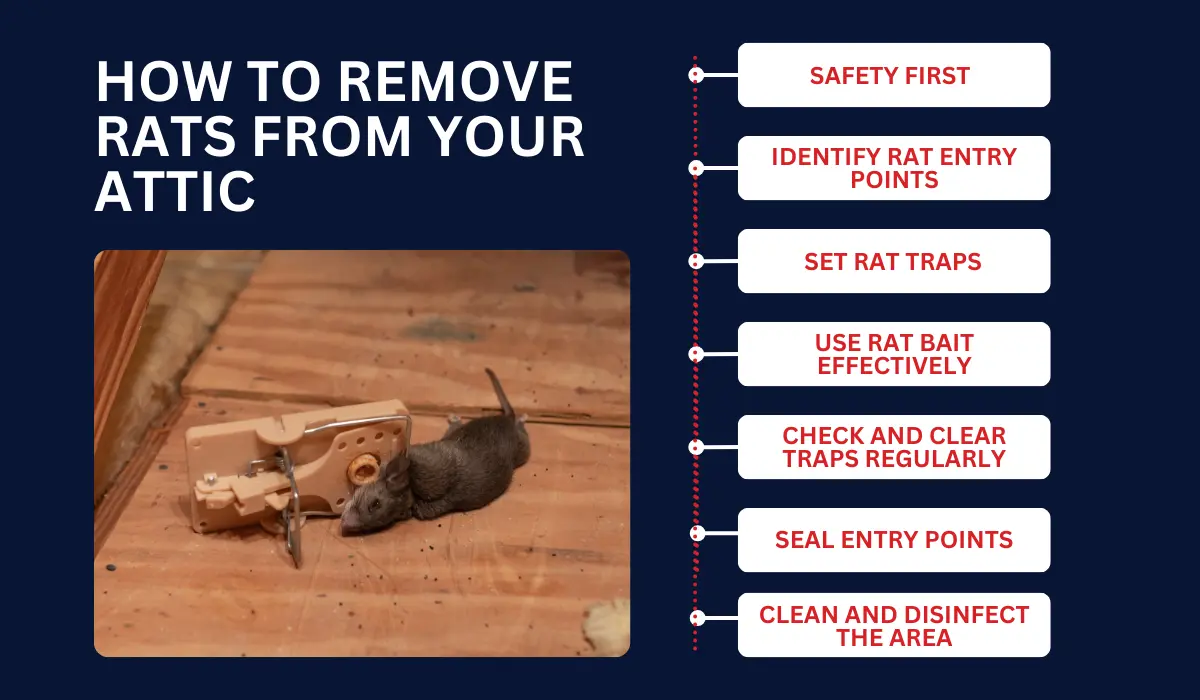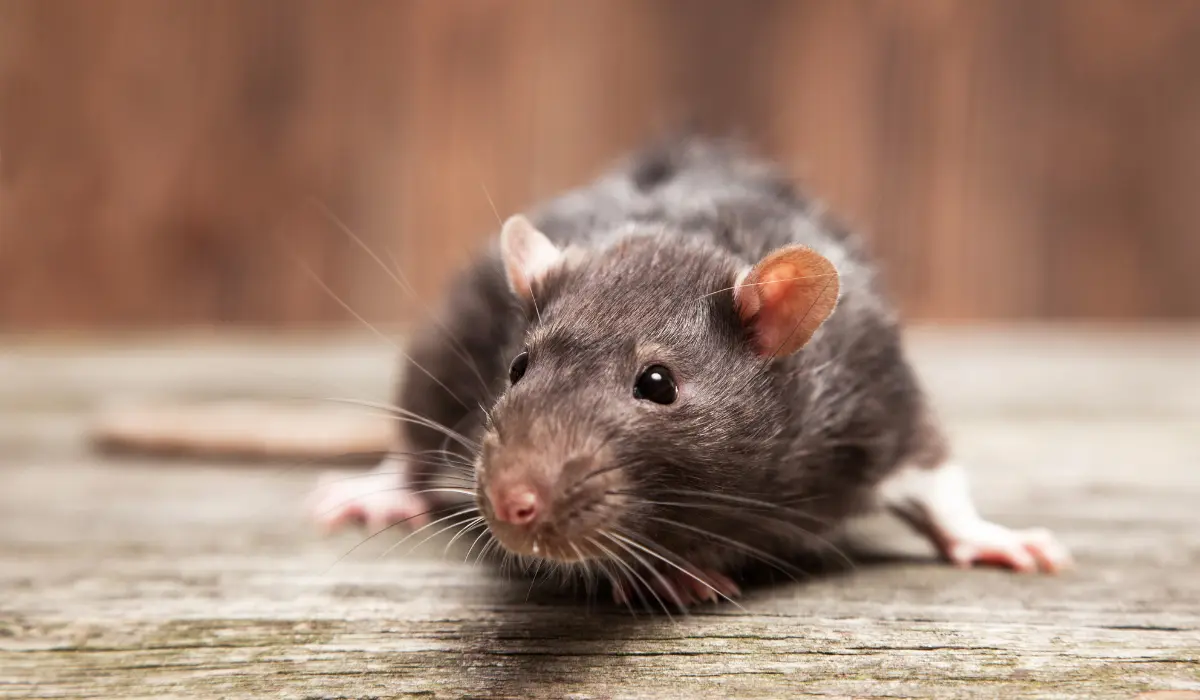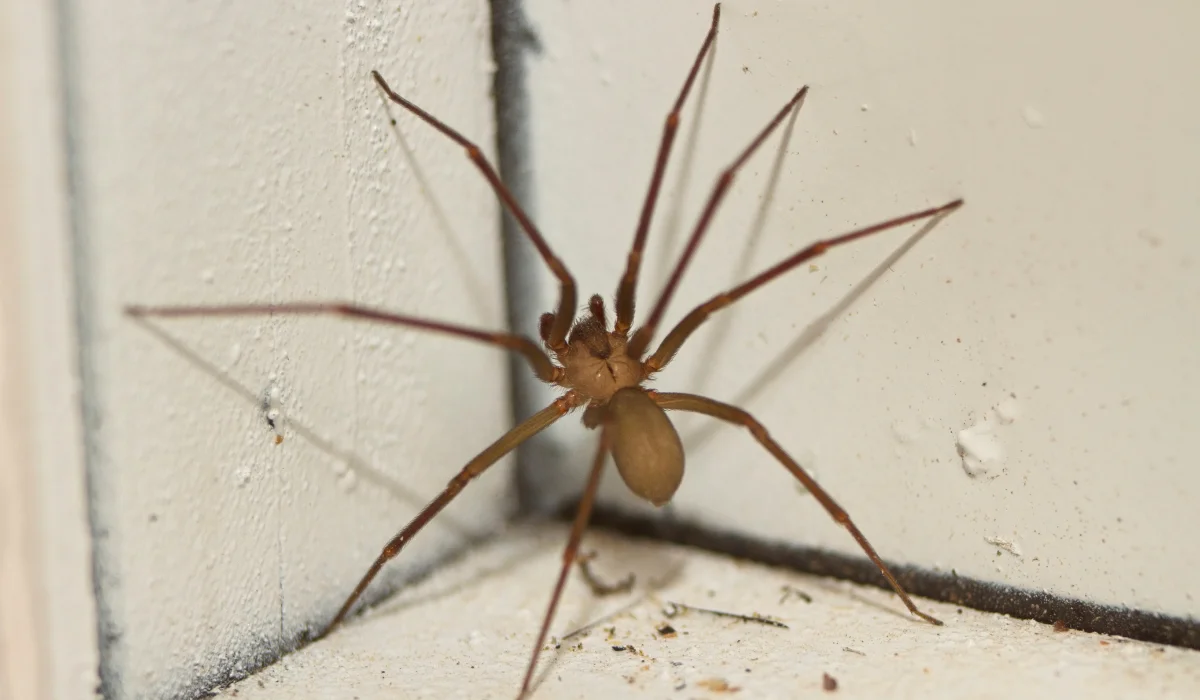Dealing with rats in your attic is more than just unsettling—it’s a serious issue that can harm your health. These pests damage wiring, insulation, and wood, posing health risks.
To tackle this, start by identifying tiny entry points—they can fit through spaces as small as a quarter. So, sealing these gaps is crucial. Then, choose humane removal methods like traps, or better yet, hire a professional.
Want rodents to be gone for good without using harsh rodenticides? Stay vigilant and read on for effective prevention tips to maintain a rat-free attic.
Key Takeaways
- Effective rat removal from your attic involves using safety gear, identifying entry points, setting traps, and sealing all entrances after eradication.
- Signs of rats in your attic include visual clues like droppings and gnawing marks, auditory signals such as scurrying and scratching noises, and distinct smells.
- Keeping rats out of your attic can be achieved by trimming trees, improving ventilation, securing food sources, and regular inspections.
- Professional pest control services provide comprehensive solutions, including assessments, tailored extermination plans, and preventive measures to manage rat infestations.
- Calling a rat expert is advisable when the infestation escalates beyond DIY control, especially when combined with other pests like termites or fleas.
HOW TO REMOVE RATS FROM YOUR ATTIC

Learning how to get rid of rats in your attic space involves several critical steps and can significantly reduce the risk of property damage and health issues like Hantavirus.
Step 1. Safety First
When dealing with rodents in Louisiana, your safety should take priority. Before starting the removal process, gather safety gear to protect against bites and disease transmission.
An essential safety checklist includes:
- Gloves
- Masks
- Protective Eyewear
- Long Sleeve Shirts and Pants
- Boots
Step 2. Identify Rat Entry Points
Locating where rats enter the attic is crucial for effective rat control. They can squeeze through small holes and gaps in your home. Look for these common entry points:
| Entry Points | Description |
| Loose Roofing Tiles | Check for wiggle room or gaps |
| Eave Gaps | The space between the eaves and roof |
| Vent Openings | Look for chew marks or droppings |
Step 3. Set Rat Traps
Choosing the correct type of trap is essential for successful rat removal. Here are some common rat or mouse trap types that serve a specific purpose:
- Snap Traps: Ideal for killing rats instantly
- Electronic Traps: Provide a quick, humane kill
- Live Traps: Allow for the release of the rat elsewhere
- Glue Traps: Considered less humane due to the potential distress and harm
Step 4. Use Rat Bait Effectively
Proper baiting increases the chances of capturing rats, so choose wisely for more effective rodent control. Consider each bait type that holds your preferred rat poison:
| Bait Types | Attractiveness |
| Peanut Butter | Highly attractive, easy to apply |
| Bacon | Strong smell lures rats |
| Fruits | Sweetness can attract rats not tempted by other baits |
Step 5. Check and Clear Traps Regularly
When you’ve set the rat traps in a strategic location in the attic, maintaining them is essential. For continuous effective management of the rat population, follow these steps:
- Check traps daily for captures.
- Handle trapped rodents with care by observing the essential safety checklist.
- Re-set traps immediately to maintain control efforts.
Step 6. Seal Entry Points
After removing the rats, ensure they can’t return by sealing their pathways. When rodent-proofing your attic, use durable materials, such as:
| Materials | Use |
| Steel Wool | Stuff into holes |
| Caulk | Seal smaller gaps and crevices |
| Wire Mesh | Cover larger openings |
Step 7. Clean and Disinfect the Area
Finally, cleaning and disinfecting the area helps prevent the spread of diseases carried by rats. Here’s what you’ll need after getting rid of mice or rats:
- Disinfectants: Choose ones effective against rodent-borne pathogens.
- Protective Gear: Gloves and masks are essential during cleanup.
- Trash Bags: Securely dispose of contaminated materials.
WHAT ARE THE SIGNS OF RATS IN YOUR ATTIC?
A quick inspection can reveal much. As homeowners, you must spot the signs of rat presence before a rat infestation develops.
Here are visual indicators to watch out for any types of rats:
| Visual Signs | Description |
| Rat Droppings | Small, dark feces, typically shaped like a spindle. |
| Gnawing Marks | Unmistakable chew marks on wood and electrical wires. |
| Rat Tracks | Greasy track marks or tail trails in dusty areas. |
| Nests | Clumps of shredded material, such as insulation. |
| Burrows or Holes | Holes in walls or around the attic, the work of Norway rats looking for shelter. |
Rats aren’t silent critters; their sounds can alert you to their presence. When the house is quiet, use this checklist to pinpoint typical rat noises:
- Scurrying: The sound of rapid movement in the ceiling at night.
- Scratching: Persistent noises in the walls or above as they travel or nest.
- Squeaking: High-pitched vocal sounds that may indicate distress or communication.
A rat’s presence can also be betrayed by the smell they leave behind or other less conspicuous signs. Here are some critical sensory indicators:
| Indicators | Description |
| Ammonia-Like Smell | A strong, stale scent similar to ammonia, a component of their urine. |
| Pet Behaviors | Cats or dogs become fixated on areas under the floors or by the walls. |
| Damage Around Entry Points | Chewed edges around holes or vents, evidence of roof rats entering and exiting. |
HOW TO KEEP RATS OUT OF YOUR ATTIC
Preventing rats from entering the attic involves a multi-step approach that may include DIY methods, regular inspection and maintenance, and sanitation practices.
Trim Trees and Shrubs Near Your Home
Landscaping is crucial to rat prevention, as overgrown branches can serve as bridges to your home. Consider this for pruning to prevent these excellent climbers from reaching your roof:
- Prune tree branches to keep them at least 6 feet from the roofline.
- Trim shrubs regularly to avoid providing cover for rats.
- Remove any ground cover that touches the walls of the home.
- Check and maintain the trimming of plants throughout the year.
Improve Ventilation
Moisture and poor ventilation can create an ideal environment for rats. Here’s how you can improve ventilation in critical areas at home:
| Locations | Improvement |
| Attic | Install roof vents or attic fans. |
| Eaves | Ensure soffit vents are unblocked and clean. |
| Home | Use dehumidifiers in damp areas to keep moisture levels low. |
Ensure Proper Food and Waste Storage
Rats are drawn to food sources; good storage practices are non-negotiable. Follow these DIY storage tips:
- Store grains and pet food in metal or heavy plastic containers in tight lids.
- Use sealed bins for trash and compost to minimize odors.
- Keep outdoor grilling areas and eating spaces clean.
Regular Inspection and Maintenance
Regular checks are critical to detecting early signs of rat problems. This table proposes maintenance routines:
| Frequencies | Task |
| Monthly | Examine the attic for droppings or nesting materials. |
| Quarterly | Check for gaps or holes in the roofline and eaves. |
| Annually | Call an exterminator for a thorough inspection. |
WHEN TO CALL A RAT EXPERT
Despite your efforts, rat problems in the attic can escalate to a level professionals best handle. As homeowners, consider seeking a pest control company when the rat situation seems out of control due to a complex infestation with termites, fleas, or other critters.
Whether you’re in New Orleans or East Baton Rouge, seeking expert help should be easy. For immediate intervention for a severe infestation, let Lajaunie’s rat control specialists tailor a solution that’s right for your home.
For more information about the areas we service, visit our location page.
 By: LaJaunie's Pest Control
By: LaJaunie's Pest Control 


